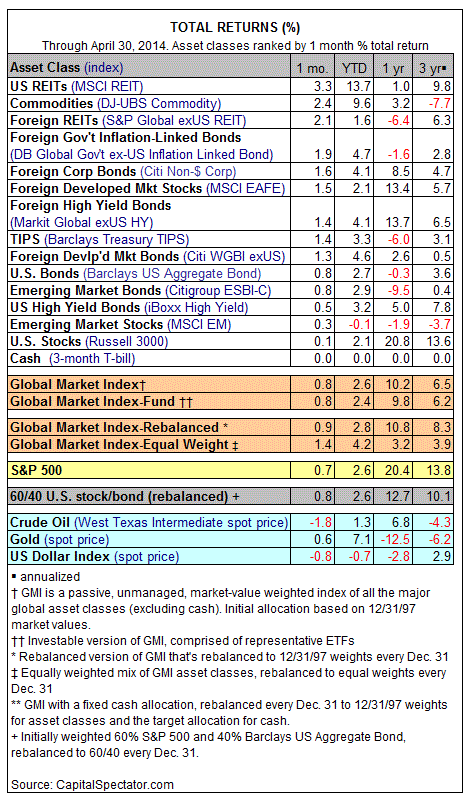April was kind to the major asset classes, at least in relative terms. All corners posted gains. The big winner: US REITs, which topped the list with a strong 3.3% total return, based on the MSCI US REIT Index. In fact, US REITs have been firing on all cylinders lately—so far this year, the asset class is comfortably in the performance lead with a hefty 13.7% advance in 2014 through the end of April. In close pursuit: commodities, which have rebounded sharply this year, gaining nearly 10% via the broadly defined DJ-UBS Commodity Index. In other words, portfolio strategies with low-to-zero weights in US REITs and commodities have endured substantial opportunity costs in recent months.
US stocks, by comparison, fell to the bottom of last month’s return ledger, advancing a slim 0.1%, based on the Russell 3000. It’s worth noting that the large-cap-oriented S&P 500 is up a good deal more: 0.7% on a total return basis for April. The unusually wide difference between the benchmarks is due to the red ink in small- and medium-cap stocks, which have a bigger influence on the broadly designed Russell 3000 vs. the S&P 500’s big-cap tilt. Indeed, the small-cap Russell 2000 Index suffered a 3.9% loss last month and is off 2.8% year to date. In sum, a bias for large stocks so far in 2014 has offered a modest performance edge.
As for a strategy of broad diversification, April was a decent if unspectacular month. The Global Market Index (GMI), an unmanaged benchmark that holds all the major asset classes in market-value weights, increased 0.8% last month. For the year so far, GMI is ahead by 2.6%, or slightly better than the 2.1% rise in a broad measure of US stocks (Russell 3000). GMI’s four-month rise implies a total return of nearly 8% for all of 2014. That’s not particularly impressive based on recent history—GMI was up 14.2% in 2013, for instance. But relative to my current long-run equilibrium-based risk premium forecast for the Global Market Index, an 8% calendar-year gain looks like pretty good.

Pingback: Thursday links: forever cyclical | Abnormal Returns
Pingback: Risk Premia Forecasts | Investor Spread
Pingback: Risk Premia Forecasts | Prompto Capital
Pingback: Asset Allocation & Rebalancing Review
Pingback: Asset Allocation And Rebalancing May Review | Investor Spread